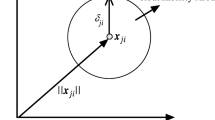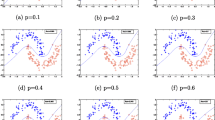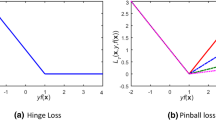Abstract
Twin support vector machine with two nonparallel classifying hyperplanes and its extensions have attracted much attention in machine learning and data mining. However, the prediction accuracy may be highly influenced when noise is involved. In particular, for the least squares case, the intractable computational burden may be incurred for large scale data. To address the above problems, we propose the double-weighted least squares twin bounded support vector machines and develop the online learning algorithms. By introducing the double-weighted mechanism, the linear and nonlinear double-weighted learning models are proposed to reduce the influence of noise. The online learning algorithms for solving the two models are developed, which can avoid computing the inverse of the large scale matrices. Furthermore, a new pruning mechanism which can avoid updating the kernel matrices in every iteration step for solving nonlinear model is also developed. Simulation results on three UCI data with noise demonstrate that the online learning algorithm for the linear double-weighted learning model can get least computation time as well considerable classification accuracy. Simulation results on UCI data and two-moons data with noise demonstrate that the nonlinear double-weighted learning model can be effectively solved by the online learning algorithm with the pruning mechanism.

Similar content being viewed by others
References
Vapnik V (1995) The nature of statistical learning theory. Springer, New York
Chen X, Yang J, Liang J (2011) Optimal locality regularized least squares support vector machine via alternating optimization. Neural Proces Lett 33(3):301–315
Li G, Meng H, Yang M (2009) Combining support vector regression with feature selection for multivariate calibration. Neural Comput Appl 18(7):813–820
Li J, Jia Y (2010) Huberized multi-class support vector machine for microarray classification. Acta Autom Sin 36:399–405
Sun C, Mu C, Li X (2009) A weighted LS-SVM approach for the identification of a class of nonlinear inverse systems. Sci China Ser F 52(5):770–779
Jayadeva R, Khemchandani S, Chandra (2007) Twin support vector machines for pattern classification. IEEE Trans Pattern Anal Mach Intell 29(5):905–910
Shao Y, Zhang C, Wang X et al (2011) Improvements on twin support vector machines. IEEE Trans Neural Netw 22(6):962–968
Tian Y, Ju X, Qi Z, Shi Y (2014) Improved twin support vector machine. Sci China Math 57(2):417–432
Sun S, Xie X (2015) Semi-supervised support vector machines with tangent space intrinsic manifold regularization. IEEE Trans Neural Netw Learn Syst. doi:10.1109/TNNLS.2015.2461009
Xie X, Sun S (2014) Multi-view Laplacian twin support vector machines. Appl Intell 41:1059–1068
Peng X (2010) TSVR: an efficient twin support vector machine for regression. Neural Netw 23(3):365–372
Kumar A, Gopal M (2009) Least squares twin support vector machines for pattern classification. Expert Syst Appl 36(4):7535–7543
Divya T, Sonali A (2015) A comparison on multi-class classification methods based on least squares twin support vector machine. Knowl-Based Syst 81:131–147
Lin C, Wang S (2002) Fuzzy support vector machines. IEEE Trans Neural Netw 13(2):464–471
Jayadeva R, Khemchandani S, Chandra (2004) Fast and robust learning through fuzzy linear proximal support vector machines. Neurocomputing 61(1–4):401–411
Lin C, Wang S (2004) Training algorithm for fuzzy support vector machines with noisy data. Pattern Recognit Lett 25(14):1647–1656
Subasi A (2012) Medical decision support system for diagnosis of neuromuscular disorders using DWT and fuzzy support vector machines. Comput Biol Med 42(8):806–815
Tang W (2011) Fuzzy SVM with a new fuzzy membership function to solve the two-class problems. Neural Process Lett 34(3):209–219
Yang X, Song Q, Wang Y (2007) A weighted support vector machine for data classification. Int J Pattern Recognit Artif Intell 21(5):961–976
Qi Z, Tian Y, Shi Y (2013) Robust twin support vector machine for pattern classification. Pattern Recognit 46(1):305–316
Xie X, Sun S (2015) Multitask centroid twin support vector machines. Neurocomputing 149:1085–1091
Wang K, Zhu W, Zhong P (2015) Robust support vector regression with generalized loss function and applications. Neural Process Lett 41:89–106
Ye Q, Zhao C, Gao S, Zheng H (2012) Weighted twin support vector machines with local information and its application. Nerual Netw 35:31–39
Ye Q, Zhao C, Ye N (2011) Localized twin SVM via convex minimization. Neurocomputing 74(4):580–587
Xu Y, Wang L (2014) K-nearest neighbor-based weighted twin support vector regression. Appl Intell 41(1):299–309
Li L, Su H, Chu J (2007) Generalized predictive control with online least squares support vector machines. Acta Autom Sin 33(11):1182–1188
Yang X, Lu J, Zhang G (2010) Adaptive pruning algorithm for least squares support vector machine classifier. Soft Comput 14(7):667–680
Wang H, Pi D, Sun Y (2007) Online SVM regression algorithm-based adaptive inverse control. Neurocomputing 70(4–6):952–959
Gu B, Wang J, Yu Y et al (2012) Accurate on-line v-support vector learning. Neural Netw 27:51–59
Wu Y, Sun S (2015) An online learning algorithm for bilinear models. In: Proceedings of the 32nd international conference on machine learning (ICML), pp 890–898
Ljung L (1999) System identification: theory for the user. Prentice Hall, Englewood Cliffs
Acknowledgments
The authors would like to thank the anonymous reviewers for their valuable comments and insightful suggestions. The authors are also thankful to National Natural Science Foundation of China (61203293, 61374079), Key Scientific and Technological Project of Henan Province (122102210131), Program for Science and Technology Innovation Talents in Universities of Henan Province (13HASTIT040), Program for Innovative Research Team (in Science and Technology) in University of Henan Province (14IRTSTHN023), Henan Higher School Funding Scheme for Young Teachers (2012GGJS-063). Backbone Teachers Program of Henan Normal University.
Author information
Authors and Affiliations
Corresponding author
Rights and permissions
About this article
Cite this article
Li, J., Cao, Y., Wang, Y. et al. Online Learning Algorithms for Double-Weighted Least Squares Twin Bounded Support Vector Machines. Neural Process Lett 45, 319–339 (2017). https://doi.org/10.1007/s11063-016-9527-9
Published:
Issue Date:
DOI: https://doi.org/10.1007/s11063-016-9527-9




